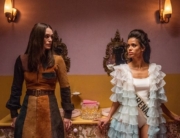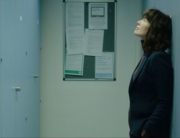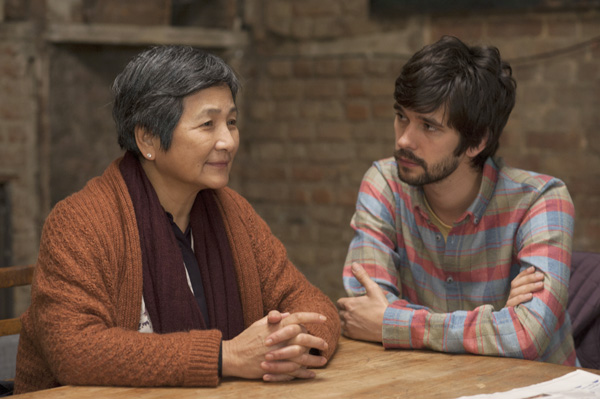Domestic architecture takes on a new and exquisite dimension in Exhibition. For British filmmaker Joanna Hogg, a house is not only a living and work space for a woman, but a reflection of her thoughts and emotions.
For almost 20 years in London’s affluent Kensington neighborhood, artists D (Viv Albertine) and her husband H (Liam Gillick) have lived in a unique town house designed by the late architect James Melvin. (H says of their time there, “It feels like 40.”) Until this home’s starring role, Melvin was most well-known for the stark glass curtain walls of modernist skyscrapers seen in any number of London-set movies. The home, built on a personal scale, has large pane windows that serve as a proscenium, placing the couple’s relationship on stage as they go up and down the central spiral staircase to new levels of emotions.
H tries to convince his wife that it’s time to move out of the house, built in 1969 for the architect for his empty nest, and the city. (It would not be a good fit for children, notes the practical real estate agent, played in a cameo by Hogg regular Tom Hiddleston.) Hogg avoids all of the usual cinematic sentimental symbols of a couple’s memories, no year-by-year height marks on a wall, no flashbacks, no past photographs marking times gone by, to let D slowly adjust to this major life change through intriguing images as she sensually re-explores the building and her body.
Though it’s a bit precious that both are artists (in their naturalistic acting debuts, Gillick is a prominent artist and Albertine a punk rocker), their different métiers here provide visual metaphors of their emotions and relationship, much more so than the limited dialogue. H, an architect, solves design problems through computer graphics and PowerPoint presentations, and is frequently just a disembodied voice on the intercom. D’s soul-searching self-portraits are more like performance art, and she stretches and dances through every space and sliding door in the house, even hanging from the ceiling (almost like Fred Astaire in Royal Wedding), as she wistfully hopes for the house’s preservation. H could also be viewed as the middle-aged version of the insecure women artists whose work intersects with their personal lives in Shannon Plumb’s Towheads from last year and Miranda July’s The Future (2011).
While outside noises constantly permeate into the house (and there are encounters with a couple of parents and an annoying neighbor), D seems to venture out a few times. Those could be dreams, when she roams to Trafalgar Square and sees herself being interviewed at the Institute of Contemporary Arts. As she frees herself from this doll’s house, she gains more and more confidence in her own self-expression. What originally seemed like her husband’s domination in pushing for the move can be interpreted as a form of support as D looks ahead to her first gallery retrospective. And the house also has a different future in store for it.
Ed Rutherford’s crisp cinematography looks inspired by Heinz Emigholz’s “Architecture as Autobiography” series that glides through modern houses without residents, and it contrasts with how the family in Mariano Cohn and Gastón Duprat’s satirical The Man Next Door (2009) tried to make the similarly-styled Le Corbusier’s Curutchet House in La Plata, Argentina, a home.
Exhibition completes Hogg’s trilogy of women in houses, though the others are temporarily occupied on vacations in Rohmer-like seasonal family gatherings unbalanced by an outsider. Also being distributed in the U.S. this year by Kino Lorber, Unrelated (2007), set in a Tuscan villa, and Archipelago (2010), in a windswept island off Cornwall, England, provide a fraught road map to see how Hogg has matured in subtly stripping down conflict and resolution to its essence.







Leave A Comment